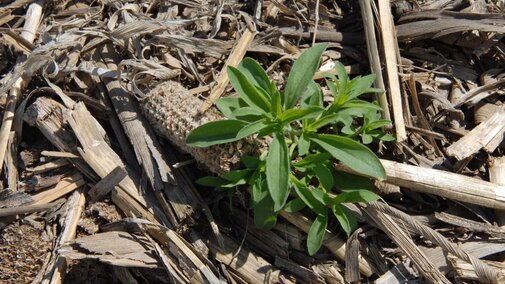Common winter annual weeds that emerge early spring in Nebraska fields are common chickweed, dandelion, downey brome, field pennycress, henbit, marestail, tansy mustard, Virginia pepperweed, etc. Profitable crop production starts with a weed control program that includes pre-plant and/or pre-emergence herbicides to deliver long-lasting, residual weed control. A spring burndown program in corn and soybean provides effective weed control to prepare for planting and helps to decrease the seedbank during the season.
Few summer annual weeds in Nebraska emerge early in the season, prior to planting corn and soybean, and need to be controlled before they grow too large. Of particular concern are kochia (Figure 1), giant ragweed (Figure 2), and marestail (Figure 3). There are numerous populations of these species in Nebraska that cannot be controlled by glyphosate as they have evolved resistance to glyphosate.



Kochia, giant ragweed, and marestail emerge in the fields at this time of the year, particularly this year when temperature is favorable and plenty of moisture is available in the soil. If you have had difficulty controlling these weeds in the last few years, make every effort to control them with an effective burndown application or tillage prior to planting.
Based on observations in our giant ragweed research studies, we had success controlling glyphosate-resistant giant ragweed with any herbicide program containing 2,4-D or dicamba as a component of a burndown application. If you apply 2,4-D or dicamba prior to planting, be sure to adhere to the planting interval specified on the label. Depending on the product, 7 to 21 days of planting interval is needed for soybean or corn. If Roundup Ready 2Xtend soybean is to be planted this spring, low volatile dicamba products (Engenia, FeXapan, Tavium, XtendiMax) can be applied and soybean can be planted any time without planting interval.
Burndown Herbicides
Among the herbicides registered for spring burndown weed control are:
Corn: 2,4-D*, Acuron, Aim, atrazine, Balance Flexx, Corvus, dicamba, DiFlexx DUO, Fierce, glyphosate, Landmaster II, Sharpen, Verdict, etc.
Soybean: 2,4-D*, Authority First, dicamba**, glyphosate, Gramoxone, Liberty, Pursuit, Sharpen, Valor, etc.
*If 2,4-D is applied at 16 fl oz/acre in a burndown program, the preplanting interval is seven days for corn and soybean; if 2,4-D is applied at a rate above 16 fl oz/acre in a burndown program, the planting interval should be 14 days for corn and 30 days for soybean.
**dicamba should be used in burndown application ONLY if Roundup Ready 2 Xtend soybean is to be planted.
Pre-emergence Herbicides
The pre-emergence (residual) herbicide protects the crop with early, effective, and lasting weed control to help maximize yields, regardless of the production system. In addition, including pre-emergence herbicides can minimize the post-emergence herbicide applications and protect against early-season weed competition when weather or busy schedules prohibit a timely post-emergence application. Among the herbicides registered for pre-emergence weed control are:
Corn: Acuron, Balance Flexx, Corvus, Degree Extra, Fulltime NXT, Lumax EZ, Outlook, Resicore, Surestart, Tripleflex, and Zemax
Soybean: Authority Edge, Boundry, Enlite, Fierce MTZ, Panther PRO, Sonic, Trivence, Valor XLT, Warrant, Zidua PRO
For More Information:
For a list of all registered burndown and pre-emergence herbicides, purchase 2020 Guide for Weed Management in Nebraska (EC130) published by University of Nebraska-Lincoln.
Always read and follow herbicide label directions.

